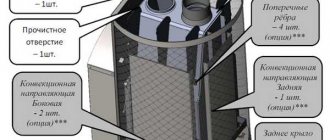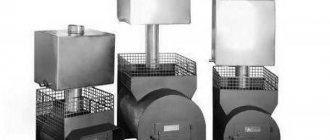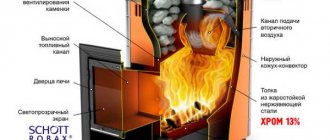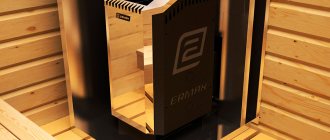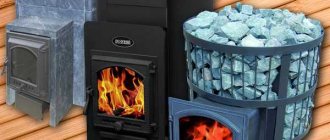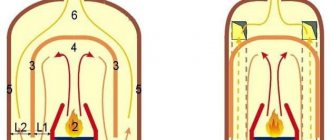For human health, the bath is one of the most useful and accessible procedures (if there are no contraindications). Its therapeutic, cosmetic and calming effect on the body has been described hundreds of times. Having your own house, cottage or country house, it is impossible to resist the temptation to build at least a small bathhouse.
If such a goal is set, then the first thing that needs to be done is to select the optimal stove option. The capabilities of the bathhouse and the comfort of its use will depend on this. There are a large number of sauna stoves on the market with different prices and characteristics. Vulcan sauna stoves have a good reputation. They are produced in the town of Odintsovo near Moscow and have a whole range of models (seven models), with many modifications. You can choose a Vulcan stove for a bath already when the dimensions of the future steam room are known. The range of models is designed for steam rooms from 8m3 to 30m3.
Requirements for a sauna firebox
An ideal firebox should have the following characteristics:
- availability;
- efficiency;
- compactness;
- fire safety;
- durability;
- ease of installation.
In addition, it should provide a lot of water intended for washing, as well as provide dry steam, which, as a rule, is much easier for humans to tolerate. (See also: Pipe sauna stove)
It is important to remember: when choosing a stove for a bathhouse, you should pay attention to the fact that it does not require a revision of the building design.
Features of Vulcan equipment
For all these parameters, the Vulcan stove is most suitable, the model range of which provides the opportunity to choose the most suitable firebox. A large heater, the weight of which varies from 75 to 150 kg, is highly appreciated by lovers of the traditional Russian bath.
Stoves for Vulcan baths have many advantages, among which it is worth noting:
- The stove has triple protection against the penetration of infrared radiation, which is ensured by the presence of a double steel casing and a large volume of stones. They are laid around the entire perimeter to a depth equal to the center line of the firebox.
- The Vulcan heater stove has maximum productivity with minimal fuel use. Fast and, at the same time, uniform heating of the steam room is ensured by a special scheme for burning wood in the firebox, which allows you to effectively use the thermal energy released when burning fuel.
- The design feature, which eliminates direct contact of welds with water, significantly increases the service life of a heating device of this brand.
- The furnace firebox is equipped with special heat exchange fins, which increase the total area of heat transfer surfaces. In addition, due to the ribs, the stones are heated more uniformly, which allows not only to save firewood, but also to increase the service life of the firebox itself.
- Wood-burning stoves for Vulcan baths have a device that allows you to clean and remove soot that accumulates in the labyrinths of the firebox, without the need to dismantle the chimney.
- This heating equipment can be installed directly on the wall, which allows the Vulcan stove to be fired from the room adjacent to the steam room. For this, a decorative firebox is used.
(See also: Wood-burning sauna stoves)
(See also: How to choose a stove)
The developers of the Vulcan sauna stove provide a guarantee for their products, which is two years from the date of installation. In addition, they are ready to provide a 30 percent discount on the purchase of a new one if the old stove is returned to the company after long-term use. (See also: Installing a sauna stove with your own hands)
Heating stoves "Vulcan Alpina"
In addition to bathhouses, Vulcan also produces Alpina heating stoves in several modifications. These powerful stoves are designed to heat large rooms. Even the smallest of them (the “mini” modification) can heat a room with a volume of up to 50 m3. But “Mini” is positioned as a heating wood stove for non-residential premises: its appearance is not the most presentable, but the power for its small size (500 * 310 * 570 mm) is very decent. The stove can only be heated with wood; the size of the log is no more than 45 cm.
Heating stoves “Vulcan Alpina” (Mini on the right)
The second most powerful model of this family, Alpina-200, can heat a room of up to 200 m3. The most powerful “Alpina 250” is designed for a volume of 250 m3. The firebox is made of carbon steel 5mm thick. There is a channel for afterburning gases, which ensures long-term combustion: one full load of firewood burns for 15-20 hours. This model has two fuel doors, which allows you to stack the maximum amount of firewood and achieve long burning. For maximum heat transfer, the housing has corrugated walls. If you want to organize air heating of the room - Alpina is an effective and inexpensive solution, and the stove is compact - 614 * 412 * 725 mm, weight 85 kg. Easy to install: a non-flammable base is required, which can be a sheet of iron laid on an asbestos sheet or any other heat-insulating material. It is also necessary to connect a chimney with efficient draft. There are no other requirements.
Briefly about the history of the bathhouse
According to tradition, the classic Russian bathhouse was equipped with a heater stove, the peculiarity of which was the absence of open fire. This made it possible to take bath procedures for a long time, while feeling special comfort, since the oxygen did not burn out. The advantages of using such a stove were that it provided heating of the room with the required temperature of 90 degrees.
The very first wood-burning stove was a well made of clay brick, which was not at all afraid of fire. Cobblestones were placed in it, and a boiler with water was placed. The fire heated the stones, which gave off their heat to the room. And to get steam, you just had to splash water on the hot stones. The very first wood-burning firebox smoked in the room itself, since combustion products were removed through the door. Smoke exhaust pipes were invented a little later.
What did a typical bathing day look like in the old days?
To begin with, the stove was heated for a long time until the last log burned out. After complete burning of the coals, ash was formed, which was subsequently raked out from there. Next, the stones should be lightly washed, and you could begin taking bath procedures. (See also: Accessories for furnaces)
The disadvantage of such a stove was the large amount of smoke, which made it difficult to enter the room in order to throw another batch of firewood into the firebox. Until all the smoke completely dissipated, it was impossible to wash. And after the installation of chimneys, bathing procedures became more comfortable, which increased their popularity.
Today, thanks to the use of the Vulcan sauna stove, you can get clean steam without any hassle and wash yourself without fear of getting smoke in your eyes. In addition, it perfectly dries the room after water procedures are completed.
How to choose stones?
When constructing a Vulcan sauna stove, stones play an important role, the choice of which determines how pleasant the warmth will be. According to experts, it is necessary to take 40 kilograms of stones per cubic meter of room volume. The stones themselves also have special requirements. They should not expand from heat, crumble or crack during use.
Most often, stones that have a round shape are used. They are collected near bodies of water or in specially equipped quarries in which special rocks are mined. Their size depends on the configuration of the furnace.
ATTENTION: to place stones in the Vulcan sauna stove, you must follow a certain sequence. The largest ones are placed at the bottom, and the smallest ones at the top. To increase the rate of heating of stones, cast iron or iron elements are placed between them. They are replaced every two years, this will increase the quality of the furnace.
Furnace design features
Unlike conventional heating stoves, a Vulcan-type sauna stove has a special structure. It is equipped with an external casing, which is designed to protect the space from the harmful effects of thermal radiation, as well as remove heat from the firebox itself. This casing is protected by a middle circuit from overheating, forming a niche for stones.
The design of a “Vulcan” type furnace includes the following main parts.
- Frame.
- Glass, poker and scoop.
- Pipe branch.
- Blower.
- Firebox door.
- Place for stones.
- Tank.
- Tap.
- Safety fence.
- Regulator for switching modes.
Internal structure of the furnace
In addition, the furnace is equipped with some additional elements that can improve the operation of the system. For example, special dividers are mounted in the firebox, which increases the heat transfer of the fuel. Special holes will help clean the chimney and firebox without disturbing the overall structure. This stove also has an ash pan, which is designed to collect ash and regulate draft.
Special ribs are installed in the upper part of the firebox to increase the area of heat transfer surfaces, thereby improving the heat transfer process. It is thanks to these design features that the stones heat up quickly and evenly.
During the heating process, the water begins to evaporate, filling the steam room with the required amount of steam. The steam release process can be regulated using special valves built into the oven.
It should also be noted that the outer coating of the stove provides high thermal insulation. This is heat-resistant enamel, which allows the owner of the unit not to think about external influences. If you want to add an original element, the design allows you to install doors made of heat-resistant glass.
Fuel types
A volcano sauna stove is most often heated with hardwood firewood, which is prepared and dried in advance. The fuel must be dry; the owners build a special room or shed for its storage.
Vulcan sauna stoves are very rarely heated with coal, as it can produce too high a temperature, which can destroy the masonry. Birch logs are rightfully considered the most common fuel, since they are good at everything except that they leave a lot of soot behind. In order to clean the chimney from it, the stove is heated with aspen wood.
Do-it-yourself stove installation
You will need to purchase:
- cement;
- sand;
- crushed stone;
- heat-resistant brick;
- asbestos sheets;
- galvanized steel sheet;
- expansion bolts;
- building level;
- perforator;
- hammer;
- solution container.
The “Vulcan” sauna stove must be installed in such a way that the heat from it is evenly distributed throughout all rooms: steam room, washing room, locker room, dressing room, etc.
Installation steps.
- The required foundation for a sauna stove is a concrete pad 50 cm deep.
- Next, you need to lay out the installation site of the stove with a layer of brick. The dimensions of such a base should exceed the dimensions of the oven by at least 30-40 cm.
- A sheet of asbestos is laid on top, and a sheet of stainless steel is placed on top of it.
- The furnace structure is attached to the brick with spacer bolts.
There is another method: the wall and floor adjacent to the stove are laid out with porcelain stoneware slabs measuring 120 cm wide and 140 cm high. The gap between the wall and the stove is lined with heat-insulating materials, for example, basalt wool.
Installation of a heater
Vulcan sauna stoves are installed in such a way that the heat emanating from it spreads throughout all rooms, including the washing room, steam room and dressing room. The stove is installed on a foundation made of rubble concrete, which is poured to a depth of 50 centimeters from the base of the floor. In this case, the distance between it and the base of the wall, which is 60 mm, is filled with sand. The chimney for the Vulcan stove is made of a special asbestos-cement pipe.
IMPORTANT: When installing a chimney, you need to pay attention to the location of the wooden roof elements, which should be located no closer than 150 mm from the chimney.
As a rule, ash often flies out very hot, so you need to carefully monitor the fire protection of not only the roof itself, but also neighboring buildings. To install Vulcan sauna stoves, additional components may be required. These may include stainless steel water tanks, chimney components such as roof vent covers, fasteners, side or floor guards, roof flashing seals, foil and stones.
To choose the right device such as a volcano stove-heater, you can seek advice from the specialists of the company otopimdom.ru. They are ready to help you decide on the choice of components for the bathhouse, and are also ready to install the stove in a short time. The advantage of the company is that its employees are ready to provide any information on all issues of interest.
Review of some models of Vulcan sauna stoves and reviews of them
Let's look at the pros and cons of Vulcan sauna stoves using specific models as examples. The “Vulcan” stove of the Elbrus 26 model in the “standard” modification can heat a steam room with a volume of 12 to 26 cubic meters. m. It has a powerful turbo firebox with a wall thickness (in areas of greatest load) of 10 mm. Main parameters of the furnace:
- width – 500 mm;
- depth - 720 mm;
- height - 800 mm;
- weight – 100 kg;
- weight of loaded stones up to 125 kg (in the model with a built-in stone tank 100 kg, with a heat exchanger 110 kg).
Taking into account consumer reviews, we can say that Elbrus-26 is a very efficient and reliable sauna stove with high heat output and a long service life. Due to its light weight, it is easy to install (two people required) and very easy to use. It can be equipped with a built-in 35-liter water tank; it is possible to install a heat exchanger (it can be installed to the right or left of the firebox). The pipe can be of two diameters: for a pipe 115mm and 110mm. As a disadvantage, the water in the built-in tank heats up too quickly: you have to drain hot water and add cold water, but this problem does not exist when using a remote tank.
Oven "Vulcan Elbrus" with a standard door and glass
The Vulcan Etna 20 stove (premium modification) looks very aesthetically pleasing. The panoramic door adds chic (photo above). The non-standard design - the stove is made in the shape of a large vase - deserves attention. The Etna 20 model has ribs on the body and on the pipe mesh, which provide high heat transfer: the stones laid between them heat up faster and to higher temperatures. Among the shortcomings of the model, only one circumstance can be highlighted: some users consider the stove to be too hot (this is for a Russian steam room; for use as a dry-air Finnish sauna, this stove is very good). To eliminate this drawback, you can cut off some of the fins, thereby reducing the heat transfer area.
With two heaters - open and closed - another model "Volcano Prometheus" is produced; stone laying here is 100 kg in the modification "Prometheus 16" and 200 kg in the "Prometheus 24". This is also a good and more budget option for a sauna, but you need to take into account that there is no water tank.
Stove "Volcano Prometheus" with an external heater (with and without mesh for the pipe)
More compact are the Vulcan Elbrus 16 stoves (optionally equipped with a “panorama” door or a regular size with glass). Its dimensions: 540*400*800mm, weight – 80kg, weight of laid stones – 75kg. Used for steam rooms from 6m3 to 16m3. Like other members of the family, it has a cast iron grate, which ensures high-quality combustion even of damp wood. The disadvantages of this model (and not only this one) include high heat transfer. Some users note darkening of wooden cladding due to excess heat, therefore it is advisable to erect protective screens or cladding adjacent structures with heat-resistant materials. A significant disadvantage is the lack of a built-in water tank and the inability to install a heat exchanger. This is due to the small size of the oven. As a way out, you can use mounted tank options (read about the types of water tanks here). Overall, a good budget option for small steam rooms.

